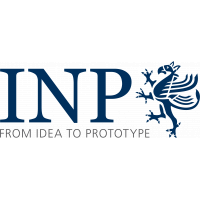The dataset provides the data related to the modelling of microdischarges in metal vapour of cadmium. Such microdischarges occur in a testing equipment for the safety assessment of electric devices for explosion protection. A one-dimensional unified non-equilibrium model that resolves the entire discharge gap is employed and simulations are conducted for a constant current of 60mA with gap lengths varying between 20 μm and 160 μm. These conditions match the experiment and enable a comparison with measured data. The predicted discharge voltage obtained as a function of the discharge length is compared to the measurements and shows a good agreement. The model provides the heat generation relevant to the prediction of a gas mixture ignition.
| Field | Value |
|---|---|
| Group | |
| Authors | |
| Release Date | 2025-09-12 |
| Identifier | 154919d7-75ef-4b51-a86a-0c653b06fb79 |
| Permanent Identifier (DOI) | |
| Permanent Identifier (URI) | |
| Is supplementing | |
| Plasma Source Name | |
| Plasma Source Application | |
| Plasma Source Specification | |
| Plasma Source Properties | The electrode configuration includes a cathode made of cadmium (Cd) and an anode made of tungsten (W) with lengths of 10mm and a diameter of 100 μm each. The length of the plasma region varies from 20 μm up to 160 μm during the contact separation. |
| Plasma Source Procedure | An electric contact of a wire (anode) is established on the rough surface of a metal block (cathode). The wire is pulled away from the surface which initiates an electric discharge. The main discharge develops in metal vapour at distances between 20 μm and ∼ 200 μm (the so-called microdischarges). The wire moves further away from the surface, the released heat causes a thermochemical reaction, which can lead to the formation and the development of a flame front. |
| Plasma Medium Name | |
| Plasma Medium Properties | The plasma is assumed to contain electrons and heavy particles of Cd atoms and singly charged Cd+ ions in their ground states. Admixture of air/H2 appears after the main microdischarge. |
| Plasma Medium Procedure | Spark ignition occurs during the contact separation at a constant current of 60 mA. Initially the spark is ignited in the metal vapour of Cd. Later on the gas characterising the explosive atmopshere (a mixture air/H2) is supposed to mix with the metal vapour. |
| Plasma Target Name | |
| Plasma Target Properties | Melting and evaporation of the cathode made of Cd. Thermo-field emission from the Cd cathode with precomputed values of the electric current density as a function of the electric field and the temperature on the cathode |
| Plasma Diagnostics Name | |
| Plasma Diagnostics Properties | A unified non-equilibrium fluid in one dimension is used to obtain the plasma parameters in Cd metal vapour. It considers the ground state atoms and singly charged ions of Cd. The model solves the equations for conservation of species, energy of electrons and heavy particles (atoms, molecules, ions), the Poison equations for the electric potential, the heat transfer in the electrodes for a current level controlled by an external circuit. A collisional-radiative model for the population of the excited states of Cd atoms can be considered in a second step. The electrical characteristics of the discharge have been studied and quasi-stationary current-voltage characteristics have been obtained by using a setup that includes a DC control system, oscilloscope, providing the electrical parameters with a time step of 1.6 μs, long distance microscope, image intensifier, and a high-speed camera. |
| Plasma Diagnostics Procedure | The model equations are solved using a fully coupled approach. The plasma domain is resolved in 1600 mesh elements and 300 elements are used for the electrodes. The electric current in the model has a constant value of 60mA. A steady-state solution is sought for a gap length of 20 μm to mimic the initial two phases of contact opening. Then, a deforming mesh approach is applied to simulate the moving electrode. The discharge gap was increased |
| Language | English |
| License | |
| Public Access Level | Public |
| Contact Name | Baeva, Margarita |
| Contact Email |
Data and Resources
- Modelling microdischarges in metal vapour of cadmium in comparison with electrical measurements - Rate coefficients as a function of the electron temperature (figure 2)csv
Rate coefficients of direct Kid, step-wise Kis, and total ionisation Ktot of...
Preview Download - TModelling microdischarges in metal vapour of cadmium in comparison with electrical measurements - Thermo-field emission current density of emitted electrons (figure 3)csv
Current density of emitted electrons due to thermo-field emission as a...
Preview Download - Modelling microdischarges in metal vapour of cadmium in comparison with electrical measurements - Measured voltage as a function of the discharge length (figure 4)csv
Measured voltage as a function of the discharge length.
Preview Download - Modelling microdischarges in metal vapour of cadmium in comparison with electrical measurements - Computed discharge voltage (figure 4)csv
Discharge voltage for discharge lengths of 60, 100, and 160 µm and values of...
Preview Download - Modelling microdischarges in metal vapour of cadmium in comparison with electrical measurements - Number density of electrons and Cd+ ions during the contact opening (figure 5)csv
Calculated number density of electrons and Cd+ ions for selected gap lengths...
Preview Download - Modelling microdischarges in metal vapour of cadmium in comparison with electrical measurements - Calculated electric potential and electric field in the discharge gap during the contact opening (figure 6)csv
Distribution of the electric potential and electric field in the discharge...
Preview Download - Modelling microdischarges in metal vapour of cadmium in comparison with electrical measurements - Computed distributions of the gas and electron temperatures in the discharge gap during the contact opening (figure 7)csv
Spatial distributions of the gas (T) and electron (Te) temperatures in the...
Preview Download

![[Open Data]](https://assets.okfn.org/images/ok_buttons/od_80x15_blue.png)